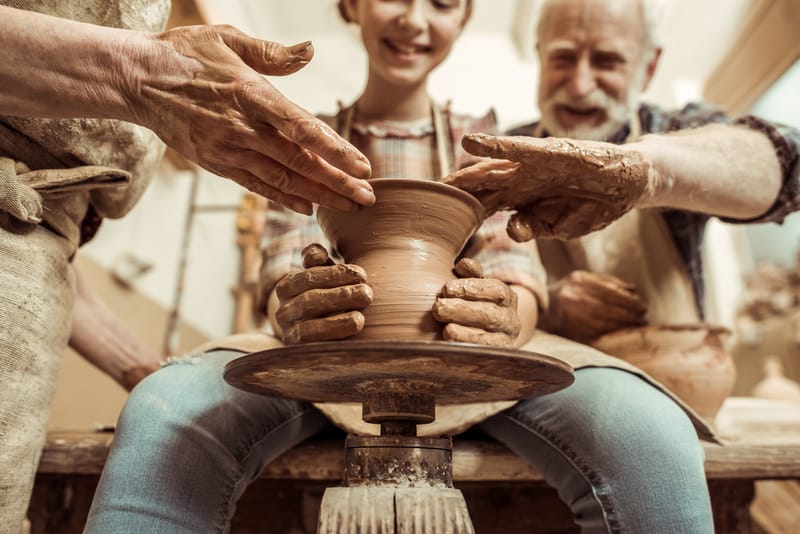You can use acupressure for the heart to manage arrhythmias, chest pains and palpitations, and as a preventative measure for more serious problems such as pericardial effusion (fluid around the heart), clogged arteries, or congestive heart failure. Performing acupressure for the heart daily will reduce stress and anxiety, lower your blood pressure, and improve cardiovascular function along with your quality of life.
Acupressure For Heart Health
Acupoint: KD-7 (Other Names: Kidney-7/Fu Liu/Returning Current)

KD-7 is an important kidney meridian acupoint and one of the key acupressure points for varicose veins. Although varicose veins do not place you at greater risk of heart disease, symptoms of the venous disease do sometimes overlap with cardiovascular conditions such as congestive heart failure.
Stimulation of the KD-7 acupoint helps to lower blood pressure and improve water metabolism. To find it, trace your way to the KD-3 acupoint, found halfway between the ankle bump and the posterior edge of the Achilles tendon. KD-7 is located three forefingers above KD-3 on the medial part of the lower leg.
Apply gentle pressure with both fingers on both the left and right calves, or try pinching with your index finger on the acupoint and your thumb on the inside of the leg.
Acupoint: SP-4 (Other Names: Spleen-4/Gong Sun/Grandfather Grandson)

This acupoint on the spleen meridian, one of the main acupressure points for the heart on the feet, is found on the medial arch, in the depression below the first metatarsal bone.
As well as being one of best acupressure points for anger management, studies indicate SP-4 to be one of the primary acupoints effective in lowering blood uric acid levels in patients with primary hyperuricemia. High blood uric acid levels are correlated with metabolic issues and cardiovascular diseases and applied pressure at the SP-4 acupoint is a great way to employ the science of acupressure for the heart.
Stimulate the SP-4 by massaging continuously with your thumb for five minutes and applying firm pressure.
Read on to learn more about acupressure points for the heart on feet.
Acupoint: BL-12 (Other Names: Urinary Bladder-12/Feng Men/Wind Gate)
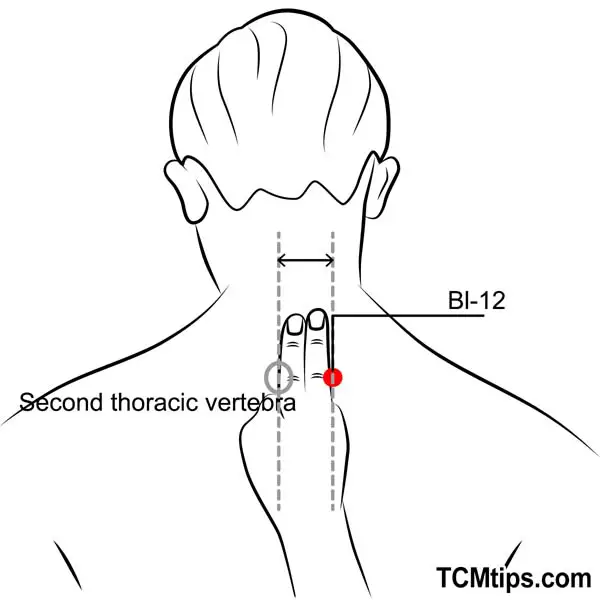
A systematic review has demonstrated the effectiveness of acupressure and acupuncture to relieve symptoms in patients with angina pectoris.
Known as the “Wind Gate,” the BL-12 acupoint is one of the primary acupressure points for chest pain. You can find it on the back, below the second thoracic vertebra, around 1.5 cun lateral to the spine.
Read on to find out more about acupressure for heart health.

Acupressure For Heart Attacks
Acupoint: PC-3 (Other Names: Pericardium-3/Qu Ze/Marsh at the Crook)

The PC-3 acupoint is located on the ulnar side of the biceps brachii tendon. Long known as one of best acupressure points for shoulder and arm nerve pain, PC-3 is also a useful acupoint for managing anxiety and panic attacks and is one of the primary acupressure points for heart palpitations.
Application of acupressure at the Pericardium-3 relieves chronic angina and heartache and may prevent the sensation of a pounding heart, potentially lowering the risk of a heart attack. Use the fingertips to apply firm pressure.
PC-3 is just one of the few acupressure points for heart attack.
Acupoint: LU-10 (Other Names: Lung-10/Yu Ji/Fish Border)

This lung meridian acupoint, located on the radial aspect of the midpoint of the thumb’s first metacarpal bone, is helpful for asthma, fever, and stomach aches and is one of the main acupressure points on the hand for shoulder pain.
Acupressure application at the Yu Ji or “Fish Border” acupoint harmonizes the stomach and the heart and helps with chest pains and cardiac issues. Stimulation of this pressure point on the thumb may help prevent heart attacks and other cardiovascular problems.
LU-10 is also the pressure point on the thumb for heart attack.
Acupressure For Heart Failure
Acupoint: HT-9 (Other Names: Heart-9/Shao Chong/Lesser Surge)

HT-9 is one of the most important heart meridian points. You can find it on the radial side of the pinky finger, approximately one finger-width from the base of the nail.
Acupressure application here opens the heart valves and is useful for relieving palpitations and cardiac pain, calming the heart, and reducing stress. Apply gentle pressure for a few minutes, and your anxiety and tension should start to ease.
Acupoint: M-UE-9 (Other Names: Ba Xie/Eight Evils)
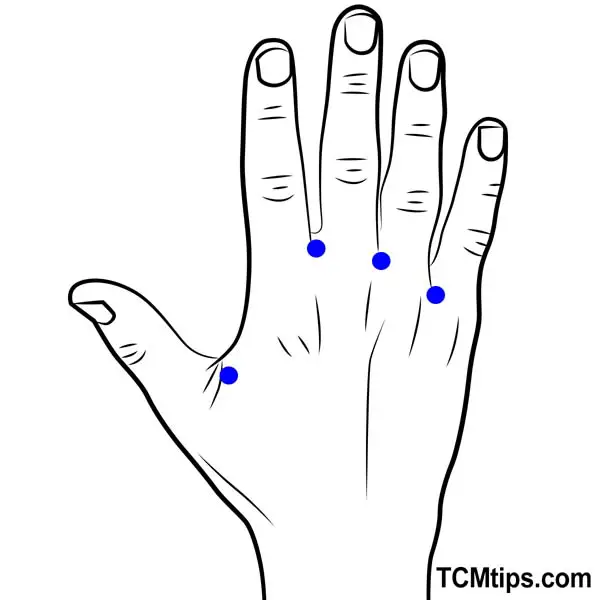
The acupressure point M-UE-9 is effective for improving circulation in the lower body. The application of acupressure here has an effect like walking out in the cold winter, promoting blood circulation and keeping the autonomic nervous system in good condition, and helping to prevent congestive heart failure.
You can find M-UE-9 on the back of the hand, at the midpoint of the proximal interphalangeal joints of the index, middle, ring, and little fingers. Due to its location on the hand, this is also one of the acupressure points for arthritis in the fingers.
To stimulate the M-UE-9, pinch the depression between each two fingers with the thumb of the other hand, and press against the joint. Apply gentle pressure for around five minutes a day. M-UE-9 is also one of the two acupressure points for congestive heart failure.
Read on to find out more about using acupressure for heart failure.
Acupressure For Fluid Around The Heart
Acupoint: Ren-17 (Other Names: The Conception Vessel-17/Shan Zhong/Middle of the Chest)

To find the Shan Zhong acupoint, count down the spaces between the ribs from below the clavicle. Shan Zhong is located in the little notch where the fourth intercostal space meets the sternum. In men, this tends to be at the level of the nipples.
Acupressure application here calms the heart, clears the chest of congestion, and relieves palpitations. Ren-17 is also one of the important acupressure points for scoliosis.
Make circles with your finger for three to five minutes, applying gentle pressure while breathing deeply.
Besides Ren-17, check out other acupressure points for fluid around the heart.
Acupressure For Heart Arrhythmia
Acupoint: HT-6 (Other Names: Heart-6/Yin Xi/Yin Cleft)
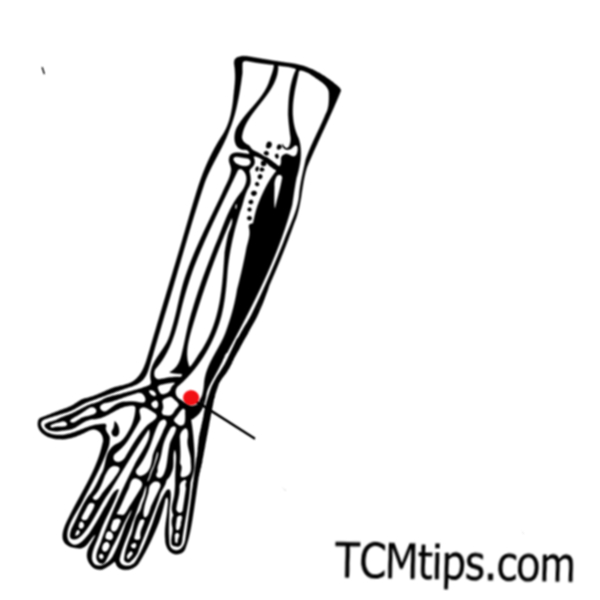
To locate the HT-6 acupressure point, measure one finger up from the wrist crease with the palm facing upwards. Known as the “Yin Cleft,” stimulation here helps to regulate the heart and relieve pains caused by an irregular heartbeat.
Application of acupressure at this acupoint also has an influence on anxiety and emotional disturbances and can be used in the treatment of night sweats or insomnia. Apply firm pressure with your thumb for three seconds, then rest for three seconds.
Acupoint: PC-8 (Other Names: Pericardium-8/Lao Gong/Palace of Toil)
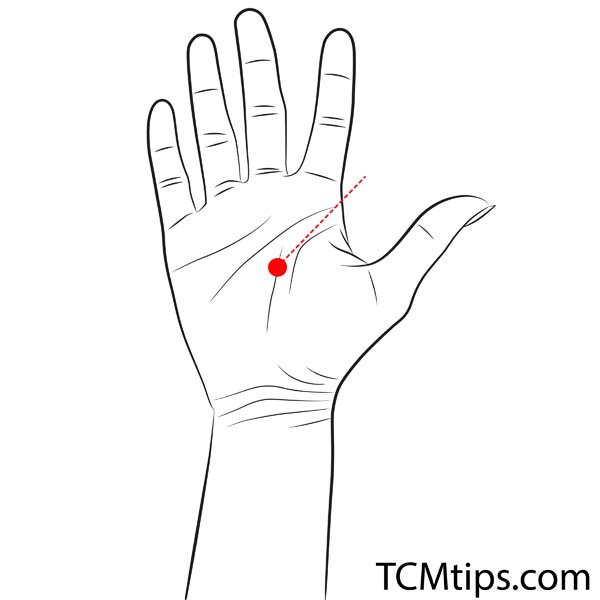
In Traditional Chinese Medicine (TCM), heart palpitations are considered as the result of a disturbance or imbalance in the Shen. PC-8, known as the “Palace of Toil,” is a useful acupoint for clearing heat from the heart and calming the Shen.
In Chinese, PC-8 is also referred to as the Lao Gong, or “Labor Palace,” and is considered one of the potent acupressure points for menopause.
You can find the PC-8 acupoint in the middle of the palm, between the bones of the second and third fingers. Apply firm pressure at this point by pressing with the thumb and moving in small circles.
PC-8 is also one of the acupressure points for heart palpitations.
Acupoint: HT-3 (Other Names: Heart-3/Shao Hai/Lesser Sea)
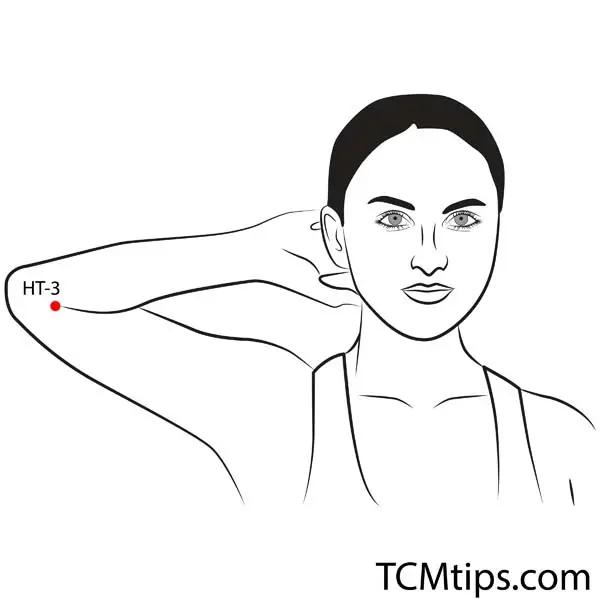
The HT-3 acupoint, known as the “Lesser Sea,” is sea of vital energy, used to move Qi from the Kidneys to the heart. As a water point on the heart channel, it helps to lower heart rate and soothe the heart and mind.
While it’s normal for the heart to quicken during exercise and slow down during rest, if you frequently experience a fast or irregular heartbeat, your heart may be straining to supply enough blood to your body. Stimulation at the HT-3 acupressure point may help to relieve palpitations caused by atrial fibrillation.
Another effect of acupressure at HT-3 is relief from pain, trembling, or numbness in the hands and wrists. This makes the Lesser Sea one of the primary acupoints employed in acupressure for ulnar nerve pain.
HT-3 is located at the tip of the medial crease of the elbow. It’s easier to find if you first bend your arm at a 45-degree angle. Apply gentle pressure at the acupoint for around five minutes.
Read on to find out more about using acupressure points for heart arrhythmia and acupressure points for atrial fibrillation.
Acupressure For Heart Valves And Clogged Arteries
Acupoint: LI-4 (Other Names: Large Intestine-4/He Gu/Joining Valley)

The LI-4 acupoint is located in the fleshy depression where the bones of the thumb and index finger meet.
It’s long been believed by practitioners of alternative medicine that the “Joining Valley,” as it is known in Chinese, is connected to the radial artery, and dissections carried out by the Aichi Medical University School of Medicine University in Japan have now confirmed this. The radial artery runs through LI-4 and is distributed in the vascular branch of the superficial branch of the radial nerve. It’s no surprise, then, that acupressure here can open up the heart valves and help to prevent coronary heart disease.
LI-4 was also one of five acupoints used in combination with the heavenly pillar acupressure point, shown to be effective in treating cervical headaches in clinical trials.
To stimulate the He Gu acupressure point, as its known in Chinese, apply firm pressure with the thumb in a circular motion on both hands.
Acupoint: Liv-3 (Other Names: Liver-3/Tai Chong/Supreme Rush)

Known as the Tai Chong (“Supreme Rush”), this acupressure point is often used alongside LI-4 to move blood and Qi throughout the body. In Traditional Chinese Medicine (TCM), hypertension is related to the category of dizziness disorders, which are believed to belong to the liver.
The effects of acupressure at the Liv-3 acupoint include relief of tension, lowering systolic blood pressure, and unclogging the chest. When combined with acupressure at the inner gate acupuncture point, LIV-3 is very effective in the treatment of tension in the chest.
The Tai Chong is found on the top of the foot, at the depression where the bone of the great toe and the index toe meet.
Acupoint: BL-15 (Other Names: Urinary Bladder-15/Xin Shu/Heart Transporter)
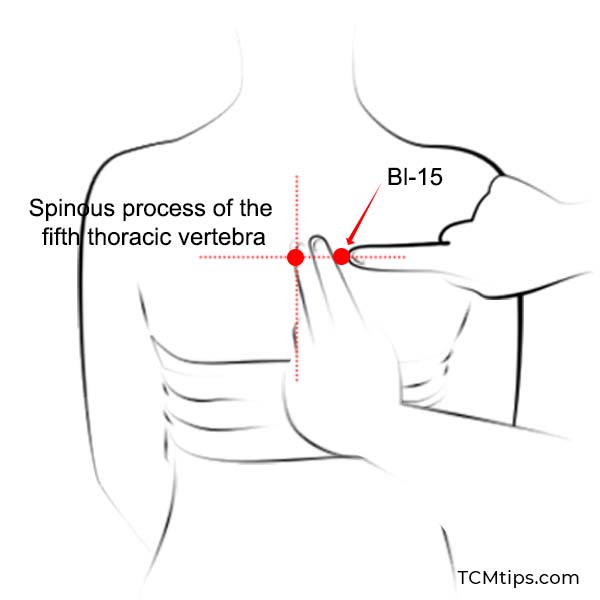
The Xin Shu acupressure point helps to regulate blood, resolve blood stagnation, and clear heat from the heart. Stimulation here can relieve heart palpitations and symptoms of cardiac disease, making it one of the key acupoints utilized in acupressure for the heart.
As well as helping to relieve blockages in the heart, the Xin Shu is one of the useful acupressure points for ovary cysts.
The Xin Shu is located on the back, around 1.5 cun lateral to the lower edge of the fifth thoracic vertebrae.
Bl-15 is also one of the excellent acupressure points for heart blockage.
Read on to find more about acupressure points for heart valves and acupressure points for clogged arteries.

Try our Anti-Aging Gua Sha Tool designed to bring out your skin’s natural glow.
Best Gua Sha Product- Anti-Aging: The tool is designed to target 11 specific aging signs such as wrinkles and sagging skin. By following the 7-step routine, users can improve skin firmness and reduce fine lines naturally.
- Enhances Skincare Routine: It works effectively with serums and lotions, boosting absorption and efficacy of skincare products.
- Visible Skin Improvement: Users can expect a smoother complexion, reduced puffiness, and a more youthful appearance.
 P. Sze
P. Sze 



